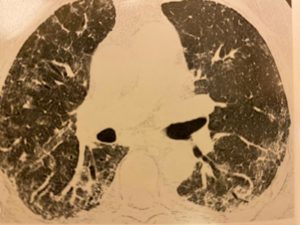Common Conditions
Pulmonary Fibrosis (PF)

What Causes Pulmonary Fibrosis (PF)?
Pulmonary fibrosis is widespread and scarring of the lung resulting in hardening and loss of function of the lungs. This condition can result from many causes such as lung infection (Tuberculosis – TB), drugs (Amiodarone, Bleomycin), inhaled chemicals (welding, cadmium oxide), asbestos exposure, radiation, autoimmune diseases (Rhenumatoid arthritis, scleroderma), occupational exposure (textiles, cotton, farming industry), gastroesophageal reflux disease (GERD) and lastly idiopathic (unknown cause).
Signs and Symptoms of PF
- Dry cough
- Breathlessness
- Frequent lung infections
- Clubbing (bulging of finger nail bed)
- Crackles in the Lungs (Velcro-like crepitations)
Diagnosing PF
- Full occupational and medical history
- Physical examination – clubbing, velcro creps
- High resolution CT thorax
- Lung biopsy – through bronchoscopy or video assisted thoracic surgery (VATS)
- Spirometry / lung volume / DLCO (lung function test)
- Oxygen saturation (oximetry) / arterial blood gases
Treating PF
- Treat the underlying conditions.
- Stop smoking
- Remove from offending agents such as asbestos, silica, cotton etc
- Drugs such Pirfenidone and Nintedanib can slow down the progression of the disease in Idiopathic Pulmonary Fibrosis. Studies are ongoing for the other conditions of PF.
- Pulmonary rehabilitation
- To provide exercise programmes, skills and tools to help manage symptoms and improve quality of life.
- Oxygen Therapy
- Prescribe for patients with very low oxygen levels in the blood. Oximeter can pick up low oxygen saturation and oxygen concentrator can provide 24 hours of oxygen daily.
- Lung Transplant
- In advanced stages of pulmonary fibrosis, a lung transplant can be considered.
